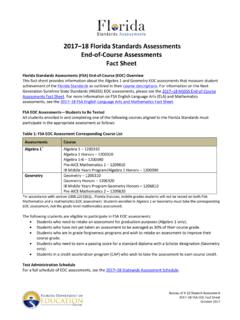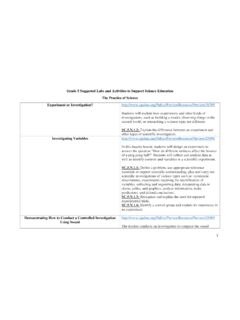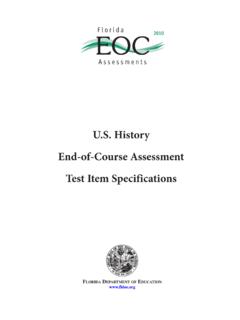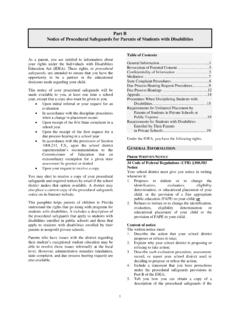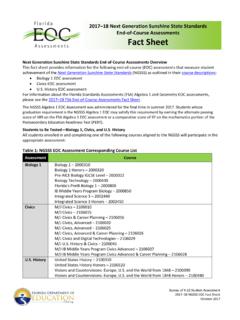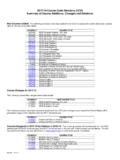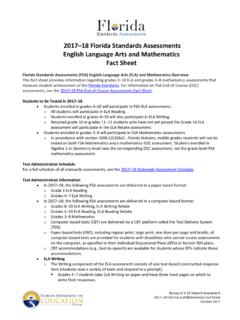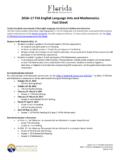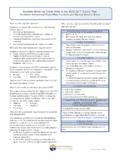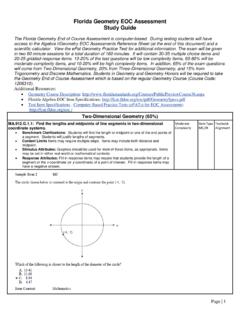Transcription of FCAT 2.0 Grade 3 Reading Sample Questions
1 Grade 3 FCAT Reading Sample Questions Student Name The intent of these Sample test materials is to orient teachers and students to the types of Questions on FCAT tests. By using these materials, students will become familiar with the types of items and response formats they will see on the actual test. The Sample Questions and answers are not intended to demonstrate the length of the actual test, nor should student responses be used as an indicator of student performance on the actual test. Additional information about test items can be found in the FCAT Test Item Specifications at The FCAT Reading tests and Sample Questions and answers are based on the 2007 Next Generation Sunshine State Standards. The Sample Questions for students and the Sample answers for teachers will only be available online, at Directions for Answering the Reading Sample Questions The Questions in this booklet are called multiple-choice Questions .
2 A multiple-choice question is followed by several answer choices. Read all the answer choices under each question and decide which answer is correct. You will fill in the bubble next to the answer choice you think is correct for each multiple-choice question. You will mark your answers in this book. If you don t understand a question, ask your teacher to explain it to you. Your teacher has the answers to the Sample Questions . Sample 3 FCAT Reading Sample Questions Read the story Swim, Baby, Swim! Then answer Numbers 1 through 9. By Mary Leister One summer morning, a young blackbird clung to a cattail stem near his nest. His mother had woven the nest from fresh grasses, but it was now brown and dry. It hung crookedly in a clump of cattails on the edge of a farm pond. The little brown bird held tightly to a stem and flapped his wings. On a nearby cattail, his father s yellow head glowed in the sun.
3 Both parents clucked nervously as they watched their last baby learn to fly. The little bird blinked his dark eyes and looked around. He saw a world of green plants and sparkling water. He fluffed up his feathers. Then he flapped his wings again and gave a little push with his feet against the cattail stem. All of a sudden, something really special happened off he went flying through the air! He wobbled as he flew across the edge of the farm pond and looked for a place to land. His toes grabbed a long thin willow branch that hung out over the water. But the branch sagged under his weight. He slipped off the end of it and plopped down into the pond! Now the little bird s parents hopped around the cattails and called to their baby. But there was nothing they could do to help him. Then something special happened again. The little bird began to swim! He dipped his wing tips low into the water.
4 When he pushed back Page 2 FCAT Reading Sample Questions florida department of education FCAT Reading Sample Questions Sample 3 with all his might just as though he were flying he moved the tiniest bit toward shore. As the young bird splashed his wings in the water, bright sparkling droplets showered on his head. The drops spilled over his back and soaked his last dry feathers. The pond looked calm and quiet. But the baby blackbird wasn t the only animal in the water. And some of the creatures big fish, bullfrogs, and snapping turtles would eat little birds whenever they had the chance. As the little bird struggled along toward shore, a female bass noticed the ripples he was making. Then the big fish saw tiny feet and wet, feathery wing tips coming toward her. She started to drift upward toward the struggling bird. Meanwhile, the bird s frantic parents were watching from the willow tree.
5 They shrieked and screamed and darted about in the branches while the young bird swam on. By now the little bird s wet feathers felt very heavy, and he was getting tired. He swam slower and slower. All the while, the bass kept moving toward him. With one more powerful Page 3 FCAT Reading Sample Questions florida department of education Sample 3 FCAT Reading Sample Questions swish of her tail and a snap of her jaws, the wet blackbird would be hers feet, feathers, and all! But just as the bass was about to lunge for the bird, an otter came streaking through the water. The fish zipped away from the hungry otter and went to find cover in the weeds. Off went the otter to search for the bass. So the little bird was safe from the fish! With a last push of his wing tips, the young blackbird reached the edge of the pond. He flapped out of the water and crawled up on shore. There he dropped onto the damp clay soil in a wet heap of feathers.
6 Now his parents circled wildly above him, squawking and shrieking. With luck, their noise would frighten away any enemies. As the young bird lay there, the rays of the summer sun warmed and dried him. He stood up and began to fluff out his feathers and straighten them with his beak. Then he stretched his wings and gave a little push with his feet against the damp clay of the shore. Off he flew into a clump of cattails growing on the other side of the pond. For the rest of that day the little bird rested in the shelter of the cattails. Meanwhile his parents still clamored and fussed. But now they also brought him all the insects he could eat. The next morning, the young bird flew away from the pond and headed for a marsh. There were plenty of dangers in the marsh, as he would soon discover. But for this day, at least, he would stay away from the pond. Swim, Baby, Swim! by Mary Leister.
7 Reprinted from the May 1990 issue of Ranger Rick magazine, with the permission of the publisher, the National Wildlife Federation. Copyright 1990 by the National Wildlife Federation. Page 4 FCAT Reading Sample Questions florida department of education FCAT Reading Sample Questions Sample 3 Now answer Numbers 1 through 9. Base your answers on the story Swim, Baby, Swim! 1 Read these sentences from the story. With one more powerful swish of her tail and a snap of her jaws, the wet blackbird would be hers feet, feathers, and all! But just as the bass was about to lunge for the bird, an otter came streaking through the water. What is the meaning of the word lunge as used in the sentences above? A to dive down and swim under him B to move quickly forward and grab him C to jump out of the pond and splash him D to turn around and swim away from him 2 What is the MOST LIKELY reason the author wrote the story Swim, Baby, Swim!
8 ? F to show how pond animals live G to tell about a bird learning to fly H to explain why fish hunt young birds I to describe how animals raise their babies 3 What is the MOST important lesson the young bird learns in this story? A Stay close to your nest. B Be careful where you land. C Swimming is easier than flying. D The marsh is safer than the pond. Page 5 FCAT Reading Sample Questions florida department of education Sample 3 FCAT Reading Sample Questions 4 How do the parents change from BEFORE the baby bird falls into the pond to AFTER he lands on the shore? F First they are calm; then they are anxious. G First they are peaceful; then they are restless. H First they are protective; then they are relaxed. I First they are nervous; then they are frightened. 5 What is the young bird s MAIN problem in the story?
9 A finding the marsh B drying his feathers C getting out of the pond D escaping from the otter 6 Read these sentences from the story. Meanwhile, the bird s frantic parents were watching from the willow tree. They shrieked and screamed and darted about in the branches while the young bird swam on. What mood does the author create by writing that the bird s parents shrieked and screamed? F gloomy G joyful H proud I scary Page 6 FCAT Reading Sample Questions florida department of education FCAT Reading Sample Questions Sample 3 7 What is the theme of the story? A Stay close to your home. B Learn from your experiences. C Keep away from your enemies. D Listen carefully to your parents. 8 Read this sentence from the story. Now the little bird s parents hopped around the cattails and called to their baby.
10 Which sentence below uses the word called the same way it is used in the sentence above? F The teacher called my name twice. G Susan called me on the phone to talk. H My coach called the plays to the team. I The new puppy was called Spot by the children. 9 Why do the young bird s parents call and scream AFTER he makes it to the shore? A They are telling their son to fly to the marsh. B They are trying to frighten away other animals. C They are thanking the otter for chasing the fish. D They are yelling at their son for falling in the pond. Page 7 FCAT Reading Sample Questions florida department of education Read the flier The Better Birdhouse! Then answer Numbers 10 through 12. The Better Birdhouse! Bird watching is a fun hobby. More people are enjoying it every day. You, too, can enjoy the gentle cooing of a mourning dove. You can watch the blue flash of a hummingbird wing as the little bird sips from a flower nearby.
